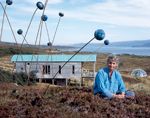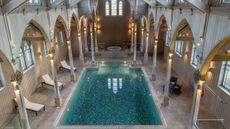Lotte Glob's ceramic studio and sculpture croft
Claire Griffiths visits the sculptor Lotte Glob at her remote Sutherland home


In a remote corner of north-west Sutherland, some 100 miles beyond Inverness, lies Loch Eriboll. Here, eagles choose to nest, 120mph winds lash at windows and then the sun will blaze down on hundreds of miles of empty coastline and the peaks of some of Britain's most challenging mountains. Things happen here, slowly but dramatically, as the weather and Atlantic regularly and visibly resculpt land and littoral. Few people choose to live here. But ceramic artist Lotte Glob knew this was the spot for her more than 40 years ago, when she first drove along the single-track road that leads past her house en route to Durness.
Originally from Denmark, Lotte has spent more than 30 years living and working in this part of the world. In 1999, she bought 16 acres of land and her vision to create a place where she could live, work and exhibit seemed possible. Her idea was to build something that would reflect and complement her work and be environmentally conscious of the surroundings. Wherever possible, she wanted the materials of the house to be from local sources and local tradespeople to do the work. The remaining acres would be turned into a 'sculpture croft', and so her vision would be complete. But with a budget just scraping £75,000, her dream seemed naïvely unrealistic.
Then she met Gökay Deveci, lecturer from the Scott Sutherland School at Robert Gordon University, Aberdeen, and an experienced architect devoted to building ecologically sound and sustainable housing. When he visited the site, Mr Deveci immediately understood Lotte's deep attachment to the area. And so he designed the house that Lotte dreamt of, which won several prestigious awards. It was also shortlisted for the Royal Inc-orporation of Architects in Scotland (RIAS) Best Building in Scotland and won the RIAS's televised public vote. Standing stilted above the loch shore, the Lotte Glob House (as it is known in archi-tectural circles) is considered by some as much a work of art as her own sculptures.
Mr Deveci has also designed a studio in the croft grounds and the 3,000 indigenous trees planted by Lotte are maturing into an impressive woodland, protected from the ravages of deer and sheep by a sturdy fence.
The house's curved roof of patinated copper has weath-ered to a rich turquoise in the past few years, and its walls, clad in untreated Scot-tish oak, have turned silver. As Mr Deveci predicted, the wide, south-facing windows of the house and studio have proved efficient in generating passive solar heating, even in winter. Now, Lotte is ready to invite people to wander freely throughout the studio and grounds, and will open them to the public this autumn.
Nestled in the heather, scuttling across the mounds or crooning knowingly to the wind, her sculptures have an innate quality of belonging here. Huge platters and deep basins scatter the studio terrace. Behind the studio, ceramic baubles float in water that reflects the changing weather. The massive ceramic-sculptured 'Books of the Land' that teeter on rocky crevices have been fired at temperatures over 2,500˚F.
Hidden among the vitrified pages are the tangible remains of rock, sediment, pebbles, glass and bone. But their pages also hold a sense of the secrets of dawn light on mountain lochans, the scent of moor and heath, naked hills and fading dusk that Lotte has experienced on her endless adventures into the surrounding hills. Having trained under Gutte Eriksen and Knut Jensen in Denmark, and Philip Pierce in Ireland, Lotte has spent a good part of her life touring, studying and exhibiting across the world. But it is from this remote northerly place that she draws her inspiration.
Sign up for the Country Life Newsletter
Exquisite houses, the beauty of Nature, and how to get the most from your life, straight to your inbox.
'When you take the first step onto the moor, it is like going into another dimension,' she explains. 'Some-thing else takes over an inner peace or dilation of the spirit and I have realised that my work has a strong identity with nature, whether in a small garden, vast landscape, a conservatory or just between plants in a window box. My creativity involves a close and intense relationship with the landscape and wilderness of the Scottish Highlands.' Lotte has no choice, she says: 'I have to live close to nature, it gives me energy, it gives me hope.' The mountains here are her eternal comrades and inspiration so where better place to view her works than the place they are most at home?
Lotte Glob's new ceramic studio and sculpture croft at 105 Laid, Loch Eriboll, Sutherland will be open to the public from September 28 to October 28, 11am to 5pm daily. Viewings by appointment only outside these dates (01971 511727; www.lotteglob.co.uk)
Country Life is unlike any other magazine: the only glossy weekly on the newsstand and the only magazine that has been guest-edited by HRH The King not once, but twice. It is a celebration of modern rural life and all its diverse joys and pleasures — that was first published in Queen Victoria's Diamond Jubilee year. Our eclectic mixture of witty and informative content — from the most up-to-date property news and commentary and a coveted glimpse inside some of the UK's best houses and gardens, to gardening, the arts and interior design, written by experts in their field — still cannot be found in print or online, anywhere else.
-
 If heaven is on earth, it might be in this home with a converted chapel that is now a swimming pool
If heaven is on earth, it might be in this home with a converted chapel that is now a swimming pool5 Wood Barton Town House is part of an exclusive 80-acre development in Devon that also comes with fishing rights on the River Avon and four bedrooms.
By James Fisher Published
-
 An Italian-inspired recipe for lemon-butter pasta shells with spring greens, ricotta and pangrattato
An Italian-inspired recipe for lemon-butter pasta shells with spring greens, ricotta and pangrattatoSpring greens are just about to come into their own, so our Kitchen Garden columnist reveals exactly what to do with them.
By Melanie Johnson Published
